Synergy Effect of High-Stability of VS4 Nanorods for Sodium Ion Battery
Abstract
:1. Introduction
2. Results
3. Materials and Methods
3.1. Synthesis of VS4 Nanorods and VS4/RGO Nanocomposite
3.2. Material Characterizations
3.3. Electrochemical Measurements
4. Conclusions
Supplementary Materials
Author Contributions
Funding
Institutional Review Board Statement
Informed Consent Statement
Data Availability Statement
Conflicts of Interest
Sample Availability
References
- Novoselov, K.S.; Geim, A.K.; Morozov, S.V.; Jiang, D.; Zhang, Y.; Dubonos, S.V.; Grigorieva, I.V.; Firsov, A.A. Electric field effect in atomically thin carbon films. Science 2004, 306, 666–669. [Google Scholar] [CrossRef] [PubMed]
- Butler, S.Z.; Hollen, S.M.; Cao, L.; Cui, Y.; Gupta, J.A.; Gutiérrez, H.R.; Heinz, T.F.; Hong, S.S.; Huang, J.; Ismach, A.F.; et al. Progress, Challenges, and Opportunities in Two-Dimensional Materials Beyond Graphene. ACS Nano 2013, 7, 2898–2926. [Google Scholar] [CrossRef]
- Zhou, J.; Lin, J.; Huang, X.; Zhou, Y.; Chen, Y.; Xia, J.; Wang, H.; Xie, Y.; Yu, H.; Lei, J.; et al. A library of atomically thin metal chalcogenides. Nature 2018, 556, 355–359. [Google Scholar] [CrossRef]
- Gupta, A.; Sakthivel, T.; Seal, S. Recent development in 2D materials beyond graphene. Prog. Mater. Sci. 2015, 73, 44–126. [Google Scholar] [CrossRef]
- Choi, W.; Choudhary, N.; Han, G.H.; Park, J.; Akinwande, D.; Lee, Y.H. Recent development of two-dimensional transition metal dichalcogenides and their applications. Mater. Today 2017, 20, 116–130. [Google Scholar] [CrossRef]
- Deng, D. Li-ion batteries: Basics, progress, and challenges. Energy Sci. Eng. 2015, 3, 385–418. [Google Scholar] [CrossRef]
- Goodenough, J.B.; Park, K.-S. The Li-Ion Rechargeable Battery: A Perspective. J. Am. Chem. Soc. 2013, 135, 1167–1176. [Google Scholar] [CrossRef] [PubMed]
- Tarascon, J.-M. Is lithium the new gold? Nat. Chem. 2010, 2, 510. [Google Scholar] [CrossRef] [PubMed]
- Choi, J.W.; Aurbach, D. Promise and reality of post-lithium-ion batteries with high energy densities. Nat. Rev. Mater. 2016, 1, 16013. [Google Scholar] [CrossRef]
- Liu, T.; Zhang, Y.; Jiang, Z.-G.; Zeng, X.; Ji, J.; Li, Z.; Gao, X.; Sun, M.; Lin, Z.; Ling, M.; et al. Exploring competitive features of stationary sodium ion batteries for electrochemical energy storage. Energy Environ. Sci. 2019, 12, 1512–1533. [Google Scholar] [CrossRef]
- Nayak, P.; Yang, L.; Brehm, W.; Adelhelm, P. From Lithium-Ion to Sodium-Ion Batteries: Advantages, Challenges, and Surprises. Angew. Chem. Int. Ed. 2017, 57, 102–120. [Google Scholar] [CrossRef] [PubMed]
- Guo, J.; Wan, F.; Wu, X.; Zhang, J. Sodium-ion batteries: Work mechanism and the research progress of key electrode materials. J. Mol. Sci. 2016, 32, 265–279. [Google Scholar] [CrossRef]
- Yabuuchi, N.; Kubota, K.; Dahbi, M.; Komaba, S. Research Development on Sodium-Ion Batteries. Chem. Rev. 2014, 114, 11636–11682. [Google Scholar] [CrossRef] [PubMed]
- Palomares, V.; Serras, P.; Villaluenga, I.; Hueso, K.B.; Carretero-González, J.; Rojo, T. Na-ion batteries, recent advances and present challenges to become low cost energy storage systems. Energy Environ. Sci. 2012, 5, 5884–5901. [Google Scholar] [CrossRef]
- Liu, Y.; Yang, C.; Zhang, Q.; Liu, M. Recent progress in the design of metal sulfides as anode materials for sodium ion batteries. Energy Storage Mater. 2019, 22, 66–95. [Google Scholar] [CrossRef]
- Zhou, J.; Wang, L.; Yang, M.; Wu, J.; Chen, F.; Huang, W.; Han, N.; Ye, H.; Zhao, F.; Li, Y.; et al. Hierarchical VS2 Nanosheet Assemblies: A Universal Host Material for the Reversible Storage of Alkali Metal Ions. Adv. Mater. 2017, 29. [Google Scholar] [CrossRef]
- Sun, R.; Wei, Q.; Sheng, J.; Shi, C.; An, Q.; Liu, S.; Mai, L. Novel layer-by-layer stacked VS2 nanosheets with intercalation pseudocapacitance for high-rate sodium ion charge storage. Nano Energy 2017, 35, 396–404. [Google Scholar] [CrossRef]
- Kang, W.; Wang, Y.; Xu, J. Recent progress in layered metal dichalcogenide nanostructures as electrodes for high-performance sodium-ion batteries. J. Mater. Chem. A 2017, 5, 7667–7690. [Google Scholar] [CrossRef]
- Yang, E.; Ji, H.; Jung, Y. Two-Dimensional Transition Metal Dichalcogenide Monolayers as Promising Sodium Ion Battery Anodes. J. Phys. Chem. C 2015, 119, 26374–26380. [Google Scholar] [CrossRef]
- Hu, P.; Long, G.; Chaturvedi, A.; Wang, S.; Tan, K.; He, Y.; Zheng, L.; Liu, G.; Ke, Y.; Zhou, Y.; et al. Agent-assisted VSSe ternary alloy single crystals as an efficient stable electrocatalyst for the hydrogen evolution reaction. J. Mater. Chem. A 2019, 7, 15714–15721. [Google Scholar] [CrossRef]
- Sun, R.; Wei, Q.; Li, Q.; Luo, W.; An, Q.; Sheng, J.; Wang, D.; Chen, W.; Mai, L. Vanadium Sulfide on Reduced Graphene Oxide Layer as a Promising Anode for Sodium Ion Battery. ACS Appl. Mater. Interfaces 2015, 7, 20902–20908. [Google Scholar] [CrossRef] [PubMed]
- Wang, Y.; Liu, Z.; Wang, C.; Yi, X.; Chen, R.; Ma, L.; Hu, Y.; Zhu, G.; Chen, T.; Tie, Z.; et al. Highly Branched VS4 Nanodendrites with 1D Atomic-Chain Structure as a Promising Cathode Material for Long-Cycling Magnesium Batteries. Adv. Mater. 2018, 30, e1802563. [Google Scholar] [CrossRef] [PubMed]
- Wang, S.; Gong, F.; Yang, S.; Liao, J.; Wu, M.; Xu, Z.; Chen, C.; Yang, X.; Zhao, F.; Wang, B.; et al. Graphene Oxide-Template Controlled Cuboid-Shaped High-Capacity VS4 Nanoparticles as Anode for Sodium-Ion Batteries. Adv. Funct. Mater. 2018, 28. [Google Scholar] [CrossRef]
- Rui, X.; Tan, H.; Yan, Q. Nanostructured metal sulfides for energy storage. Nanoscale 2014, 6, 9889–9924. [Google Scholar] [CrossRef] [PubMed]
- Deng, J.; Gong, Q.; Ye, H.; Feng, K.; Zhou, J.; Zha, C.; Wu, J.; Chen, J.; Zhong, J.; Li, Y. Rational synthesis and assembly of Ni3S4 nanorods for enhanced electrochemical sodium-ion storage. ACS Nano 2018, 12, 1829–1836. [Google Scholar] [CrossRef] [PubMed]
- Chen, B.; Li, H.; Liu, H.; Wang, X.; Xie, F.; Deng, Y.; Hu, W.; Davey, K.; Zhao, N.; Qiao, S. 1T′-ReS2 Confined in 2D-Honeycombed Carbon Nanosheets as New Anode Materials for High-Performance Sodium-Ion Batteries. Adv. Energy Mater. 2019, 9. [Google Scholar] [CrossRef]
- Liu, Q.; Gao, A.; Huang, Y.; Yi, F.; Cheng, H.; Zhao, S.; Chen, H.; Zeng, R.; Sun, Z.; Shu, D.; et al. 3D sandwiched nanosheet of MoS2/C@RGO achieved by supramolecular self-assembly method as high performance material in supercapacitor. J. Alloys Compd. 2018, 777, 1176–1183. [Google Scholar] [CrossRef]
- Wang, H.; Feng, H.; Li, J. Graphene and Graphene-like Layered Transition Metal Dichalcogenides in Energy Conversion and Storage. Small 2014, 10, 2165–2181. [Google Scholar] [CrossRef]
- Huang, P.; Wu, Y.; Wang, X.; Chen, P.; Li, S.; Ding, Y.-L. Engineering edge-exposed MoS2 nanoflakes anchored on the 3D cross-linked carbon frameworks for enhanced lithium storage. Funct. Mater. Lett. 2020, 13. [Google Scholar] [CrossRef]
- Wang, G.; Zou, J.; Kim, F. Enabling superior sodium storage behavior of MoS2 in ether-based electrolytes. Funct. Mater. Lett. 2021, 14. [Google Scholar] [CrossRef]
- Yang, G.; Zhang, B.; Feng, J.; Wang, H.; Ma, M.; Huang, K.; Liu, J.; Madhavi, S.; Shen, Z.; Huang, Y. High-Crystallinity Urchin-like VS4 Anode for High-Performance Lithium-Ion Storage. ACS Appl. Mater. Interfaces 2018, 10, 14727–14734. [Google Scholar] [CrossRef] [PubMed]
- Wang, H.; Yu, D.; Wang, X.; Niu, Z.; Chen, M.; Cheng, L.; Zhou, W.; Guo, L. Electrolyte Chemistry Enables Simultaneous Stabilization of Potassium Metal and Alloying Anode for Potassium-Ion Batteries. Angew. Chem. Int. Ed. 2019, 58, 16451–16455. [Google Scholar] [CrossRef] [PubMed]
- Qin, H.; Yang, Z.; Chen, L.; Chen, X.; Wang, L. A high-rate aqueous rechargeable zinc ion battery based on the VS4@rGO nanocomposite. J. Mater. Chem. A 2018, 6, 23757–23765. [Google Scholar] [CrossRef]
- Yu, Y.; Che, H.; Yang, X.; Deng, Y.; Li, L.; Ma, Z.-F. Non-flammable organic electrolyte for sodium-ion batteries. Electrochem. Commun. 2019, 110, 106635. [Google Scholar] [CrossRef]
- Bhide, A.; Hofmann, J.; Dürr, A.K.; Janek, J.; Adelhelm, P. Electrochemical stability of non-aqueous electrolytes for sodium-ion batteries and their compatibility with Na0.7CoO2. Phys. Chem. Chem. Phys. 2013, 16, 1987–1998. [Google Scholar] [CrossRef]
- Ponrouch, A.; Marchante, E.; Courty, M.; Tarascon, J.-M.; Palacín, M.R. In search of an optimized electrolyte for Na-ion batteries. Energy Environ. Sci. 2012, 5, 8572–8583. [Google Scholar] [CrossRef]
- Pei, S.; Cheng, H.-M. The reduction of graphene oxide. Carbon 2012, 50, 3210–3228. [Google Scholar] [CrossRef]
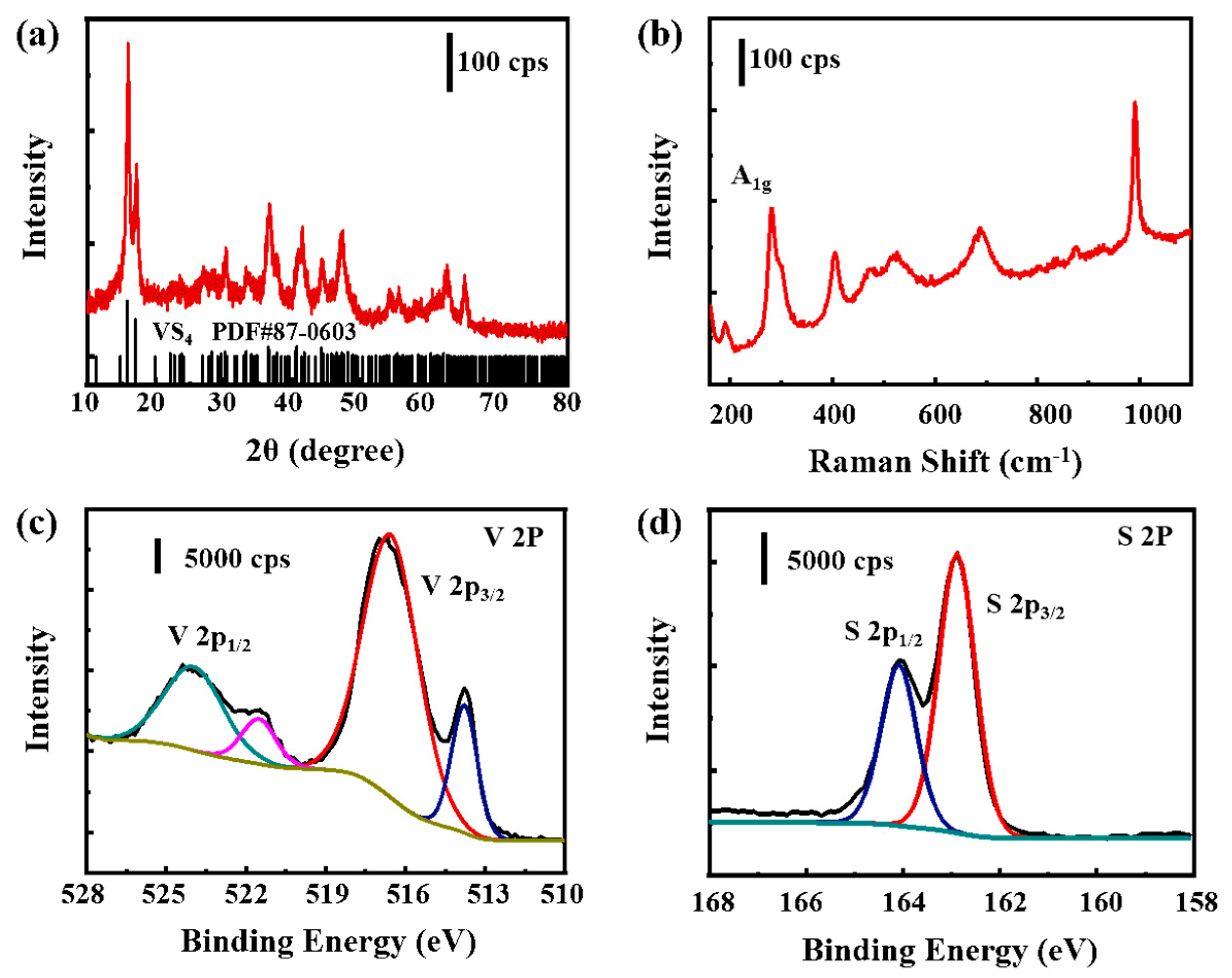
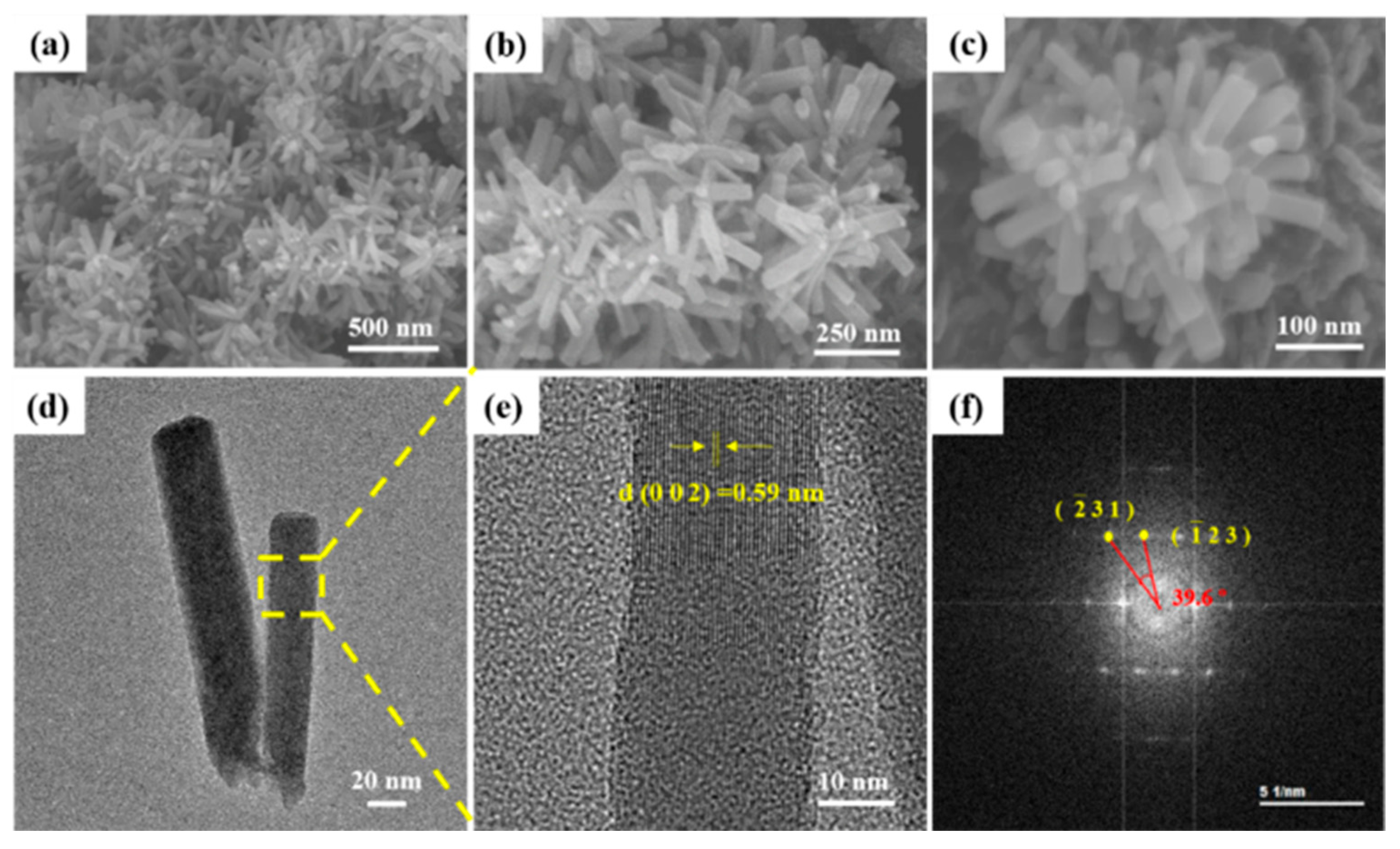
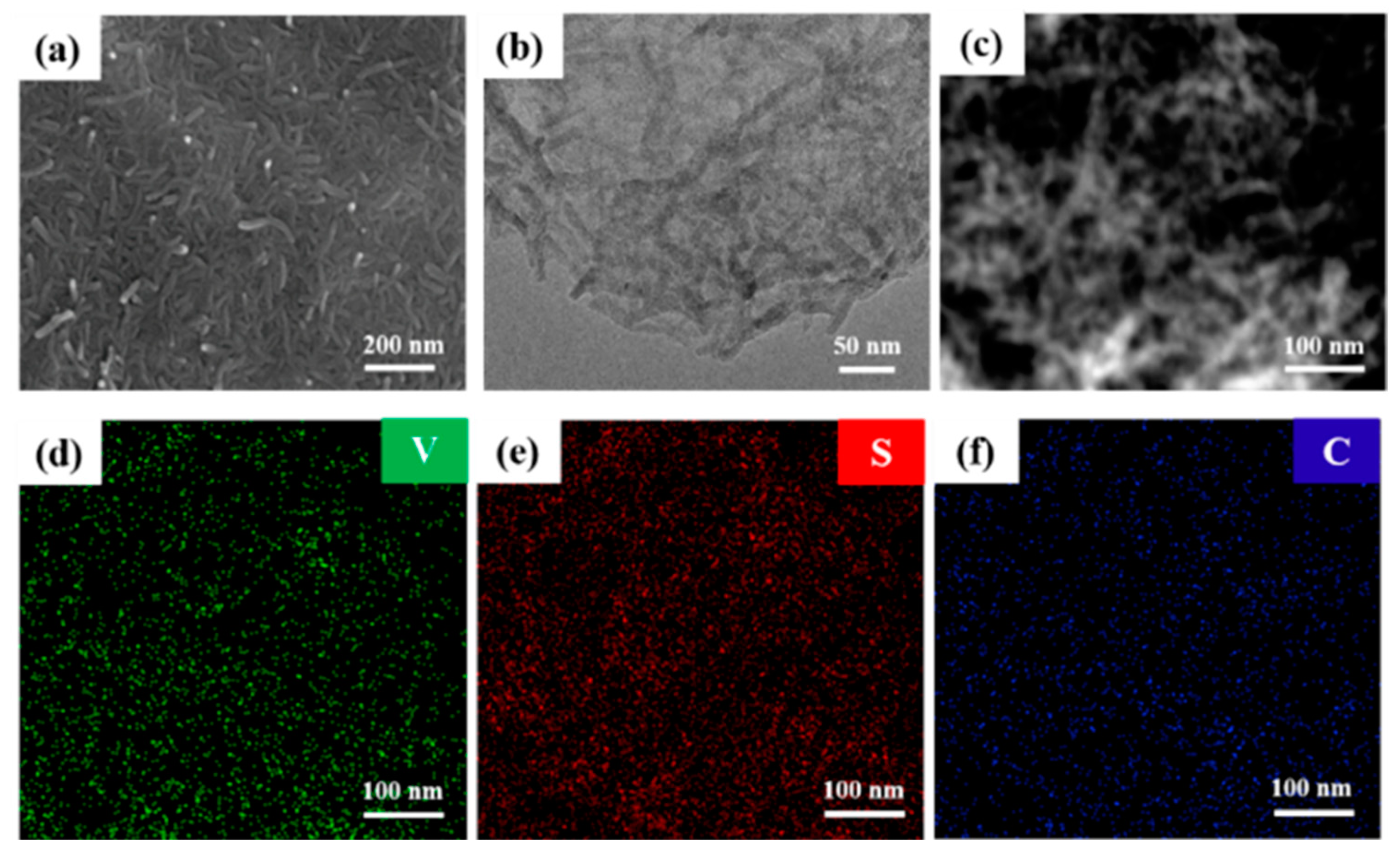
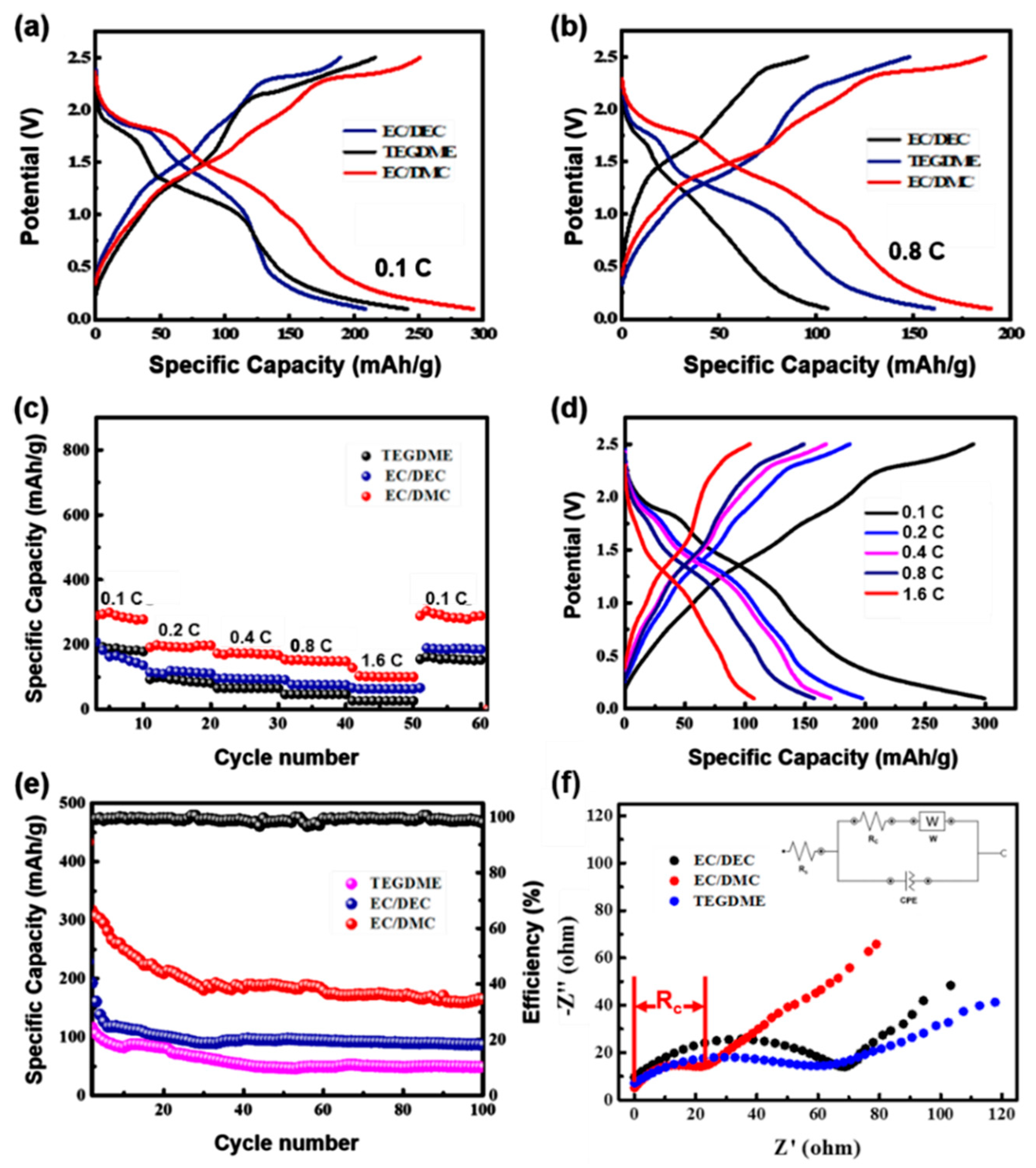
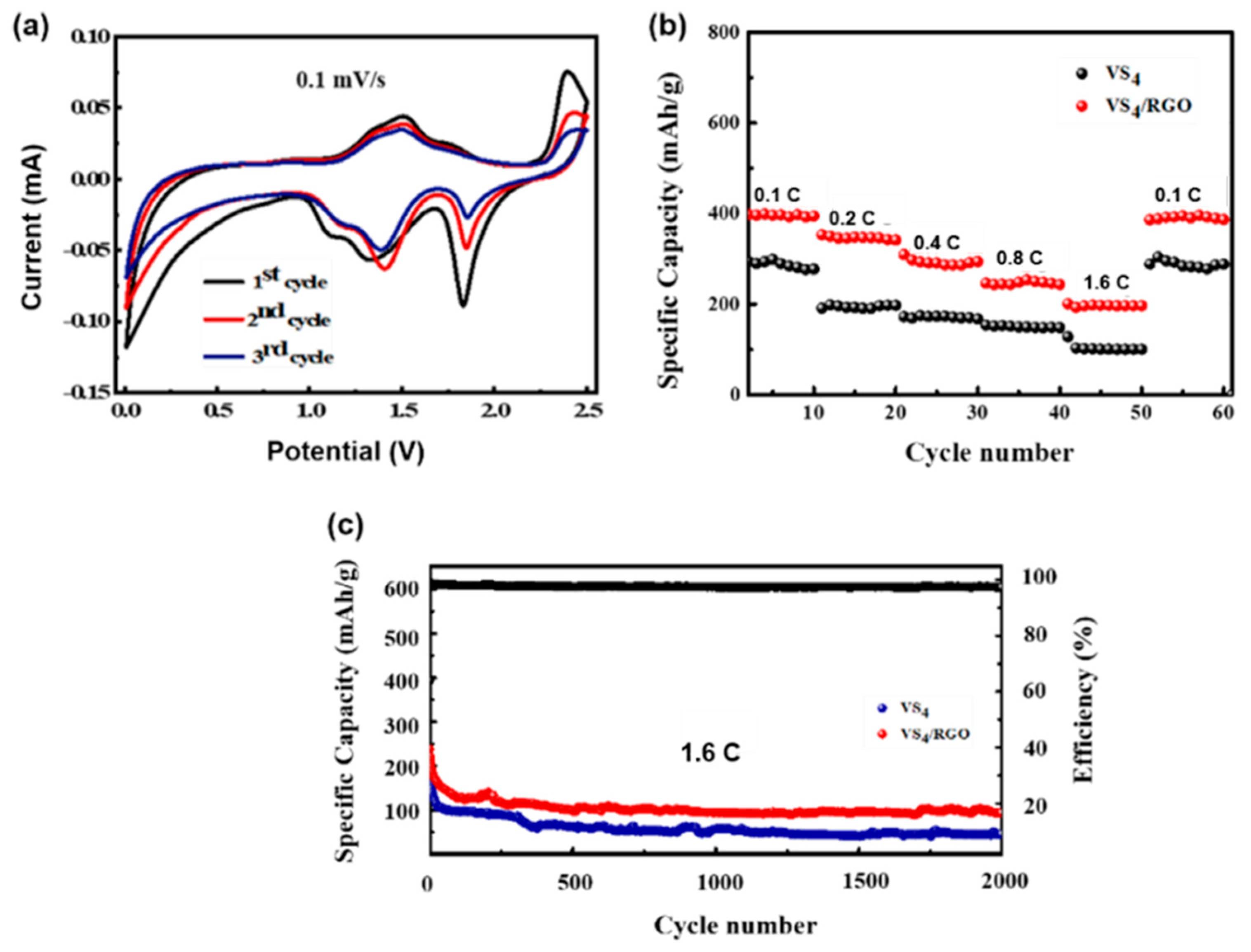

| Electrolytes | Solvation Energy (eV) | HOMO (eV) | LUMO (eV) |
|---|---|---|---|
| EC/DMC | −1.52606 | −7.64646 | −7.64646 |
| EC/DEC | −1.54102 | −7.53603 | −0.66178 |
| TEGDME | −1.43974 | −7.12885 | −0.61146 |
Publisher’s Note: MDPI stays neutral with regard to jurisdictional claims in published maps and institutional affiliations. |
© 2022 by the authors. Licensee MDPI, Basel, Switzerland. This article is an open access article distributed under the terms and conditions of the Creative Commons Attribution (CC BY) license (https://creativecommons.org/licenses/by/4.0/).
Share and Cite
Chen, Y.; Qi, H.; Sun, J.; Lei, Z.; Liu, Z.-H.; Hu, P.; He, X. Synergy Effect of High-Stability of VS4 Nanorods for Sodium Ion Battery. Molecules 2022, 27, 6303. https://doi.org/10.3390/molecules27196303
Chen Y, Qi H, Sun J, Lei Z, Liu Z-H, Hu P, He X. Synergy Effect of High-Stability of VS4 Nanorods for Sodium Ion Battery. Molecules. 2022; 27(19):6303. https://doi.org/10.3390/molecules27196303
Chicago/Turabian StyleChen, Yi, Haimei Qi, Jie Sun, Zhibin Lei, Zong-Huai Liu, Peng Hu, and Xuexia He. 2022. "Synergy Effect of High-Stability of VS4 Nanorods for Sodium Ion Battery" Molecules 27, no. 19: 6303. https://doi.org/10.3390/molecules27196303






